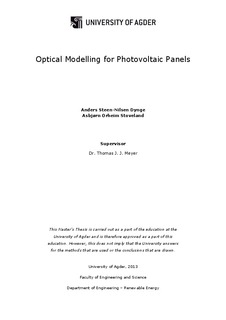Optical modelling for photovoltaic panels
Master thesis
Permanent lenke
http://hdl.handle.net/11250/136733Utgivelsesdato
2013Metadata
Vis full innførselSamlinger
Sammendrag
A novel approach to predict the performance of anti-reflective glasses on PV panel is presented in this thesis. Anti-reflective glass, such as deeply textured and thin film coated glass, has shown to increase the annual energy production relative to plain glass cover by 2-5%. The type of glass cover is an important factor for the performance of photovoltaic panels, and if properly optimized, glasses can turn into a cost-effective active component in the design of PV panels. Common practice for evaluating anti-reflective glass covers today is to evaluate measurements performed under standard test conditions (STC). However these measurements fail to quantify performance under different incidence angles and diffuse irradiance. Outdoor measurements take these effects into account, but local atmospheric and terrestrial effects greatly influence the results. In consequence outdoor measurements cannot be used to predict the performance of a specific glass cover in a different location. Therefore comprehensive evaluation tools are essential for optimal design of PV panel installations for specific geographical locations. In this study optical models that take in account angular and spectral variation under direct and diffuse light are presented. In ray tracing simulations the performance under both direct and diffuse irradiance for five different anti-reflective glass designs is investigated under equal conditions.
It is found that inverted pyramids and cube corners textured glass as well as thin film coated glass result in increase of both power and annual produced energy. Under direct irradiation thin film ARC coating resulted in the highest gain, approximately 4%, for incidence angles up to 60 degrees. However the study under diffuse irradiance showed that thin film ARC coating were outperformed by textured glass (e.g. inverted pyramids and cube corners textured).
Using the optical simulation results and PVsyst, yearly power generation simulations were performed and despite the fact that ARC thin films were the optimum design under direct irradiance the overall results showed that the textured glass, e.g. inverted pyramids and cube corners result in respectively, 6.2% and 6.6% gain in annual energy production, while thin film ARC results in 4.2%. The location chosen for the PVsyst simulation was Singapore.
Such results implies that “STC” parameters measured under normal incidence are not sufficient in the design process of a PV panel since diffuse irradiation plays a role in the generated power. As the diffuse fraction of global irradiance varies from one location to the next, the glass cover should be optimized for a given location.
Beskrivelse
Masteroppgave i fornybar energi ENE500 2013 – Universitetet i Agder, Grimstad
